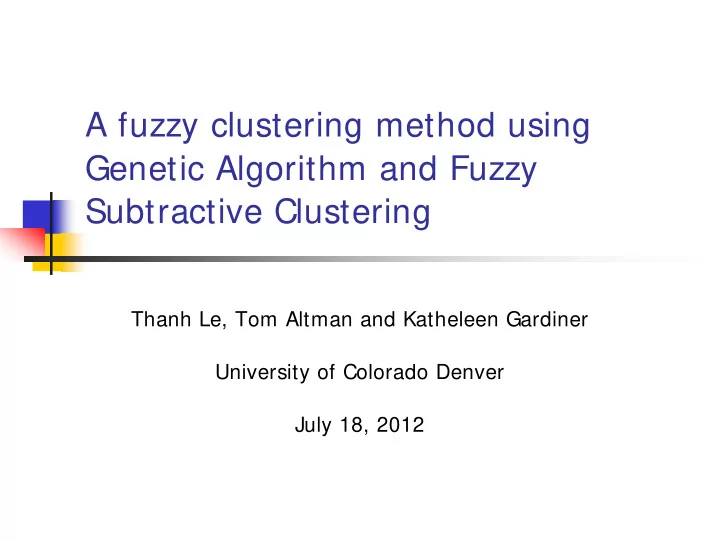

A fuzzy clustering method using Genetic Algorithm and Fuzzy Subtractive Clustering Thanh Le, Tom Altman and Katheleen Gardiner University of Colorado Denver July 18, 2012
Overview Introduction Fuzzy clustering using Fuzzy C-Means algorithm Current genetic algorithms for fuzzy clustering Proposed method: fzGASCE Genetic algorithm Fuzzy subtractive clustering Probability based fitness function Datasets: Artificial datasets: Finite mixture model Real datasets: UCI repository Experimental results Discussion
Fuzzy C-Means algorithm- FCM Objective function n c ∑∑ = − 2 → ≥ m J ( X | U , V ) u x v min, m 1 ki i k = = i 1 k 1 c ∑ = = u 1 , i 1 .. n ki = k 1 Model parameters estimation: 1 1 m - 1 m - 1 c 1 1 ∑ = u ki 2 2 − − x v x v = l 1 i k i l n n ∑ ∑ = m m v u x u k ki i ki = = i 1 i 1
FCM algorithm (contd.) Advantages Model free Rapid convergence Multiple cluster assignment Shortcomings Definition of the number of clusters Fuzzy partition evaluation Convergence to local optima Defuzzification
Recent fuzzy clustering Genetic Algorithms (GA) Chromosome describes a clustering solution Fitness functions are based on cluster indices Random mutations Genes to be replaced Genes to replace
Recent fuzzy clustering GAs (contd.) Advantages Search for the ‘best’ solution in the solution space Can escape local optima Cross-over operator Mutation operator Can determine the number of clusters using the ‘best’ solution
Recent fuzzy clustering GAs (contd.) Shortcomings Problem with cluster indices Scale between compactness and separartion Random selection of genes to be replaced Improper defuzzification
Fuzzy clustering using GA and Subtractive Clustering - fzGASCE Chromosome describes a clustering solution Data clustering using FCM Probability based fitness function Mutation gene selection using fuzzy Subtractive Clustering Defuzzification of fuzzy partition using probabilistic model
fzGASCE: the probabilistic model Bayesian validation method for fuzzy clustering - fzBLE (Le et al. , 2011) Central limit theorem Bayesian theory Possibility to probability transformation { u ki } i= 1..n - possibility distribution of X at v k { p ki } i= 1..n - probability distribution of X at v k , Create the probabilistic model at v k using { p ki } i= 1..n
Use of fzGASCE probabilistic model fzGASCE fitness function fit({ U,V} ) = Prob(X|{ U,V} ) Address the problems with using cluster indices Outperform cluster indices on artificial and real datasets (Le et al., 2011) Defuzzification of fuzzy partition Prob(v * |x i ) = max{ Prob(v k | x i )} Address the problems of maximum membership and spatial information methods (Le et al. 2012)
Application of fuzzy Subtractive Clustering (fzSC) in fzGASCE fzSC method (Le et al., 2011) Fuzzy mathematics application Histogram based density estimation Data density using fuzzy partition Application of fzSC in fzGASCE Order data points based on data densities The most dense data points are used to replace mutated genes
fzSC – an example on how it works Red-circle : Cluster centers of fuzzy partition Back-circle : The most dense data points found by fzSC fzSC demonstration available online: http://demo.tinyray.com/fzsc0
Datasets Artificial datasets Datasets generated using finite mixture model Non-uniform dataset Clusters differ in size and density Real datasets Iris Wine Glass These datasets are from UC Irvine Machine Learning
Performance measures Correctness ratio N 1 ∑ = − ˆ COR I ( c c ) N = i 1 where, N is the number of trials Error variance 1 = − 2 ˆ EVAR ( c c ) N Misclassification N n 1 1 ∑ ∑ = − c l EMIS I ( x x ) i i N n = = t 1 i 1 Compare the cluster label of each data object with its actual class label
Uniform dataset – ASET1 Algorithm COR EVAR EMI S fzGASCE 1.000 0.000 0.000 fzGAE 0.640 0.500 0.000 PBMF 0.510 0.590 0.000 MPC 0.290 0.970 0.000 HPK 0.100 5.010 0.021 AGFCM 0.600 2.800 0.000 0.490 1.450 0.000 XB 0.120 1.100 0.070 FS PC 0.230 1.040 0.000 ACVI 0.200 2.490 0.011 fzGAE is an immature version of fzGASCE, where the fzSC method is not used in the mutation operator
Uniform dataset – ASET2 Algorithm COR EVAR EMI S fzGASCE 1.000 0.000 0.000 fzGAE 0.710 0.380 0.000 PBMF 0.600 0.450 0.000 MPC 0.610 0.860 0.000 HPK 0.120 5.240 0.000 AGFCM 0.650 1.490 0.000 XB 0.640 0.430 0.000 FS 0.520 0.840 0.011 PC 0.620 0.890 0.000 ACVI 0.100 2.100 0.000
Non-uniform dataset – ASET4 Algorithm COR EVAR EMI S fzGASCE 1.000 0.000 0.000 0.900 0.100 0.107 fzGAE PBMF 0.700 0.300 0.107 MPC 0.050 0.960 0.107 HPK 0.000 5.770 - AGFCM 0.000 8.470 - XB 0.040 0.960 0.107 FS 0.020 3.480 0.107 0.050 0.960 0.107 PC ACVI 0.080 0.920 0.107
Iris dataset Algorithm COR EVAR EMI S fzGASCE 1.000 0.000 0.033 fzGAE 0.880 0.120 0.040 PBMF 0.860 0.140 0.040 MPC 0.040 0.970 0.160 HPK 0.000 5.720 - AGFCM 0.000 8.120 - XB 0.050 1.010 0.040 0.390 0.780 0.154 FS PC 0.080 0.920 0.115 ACVI 0.150 0.850 0.040
Wine dataset Algorithm COR EVAR EMI S fzGASCE 1.000 0.000 0.213 fzGAE 0.860 0.140 0.303 PBMF 0.000 2.050 - MPC 0.000 2.810 - HPK 0.000 6.760 - AGFCM 0.000 9.210 - XB 0.270 1.010 0.303 FS 0.000 5.720 - PC 0.110 0.920 0.303 ACVI 0.090 0.910 0.303
Advantages of fzGASCE Describe the data distribution using probabilistic model Apply the probabilistic model into fitness function and defuzzification Use of fzSC method with mutation operator to effectively escape local optima No parameters to be specified a priori
Future work Eliminate the oscillation during the convergence process when using fzSC to speed up fzGASCE Integrate with external distance measures to meet specific requirements of real-world applications.
Thank you! Questions? We acknowledge the supports from Vietnamese Ministry of Education and Training, the 322 scholarship program. University of Colorado Denver, USA
Recommend
More recommend